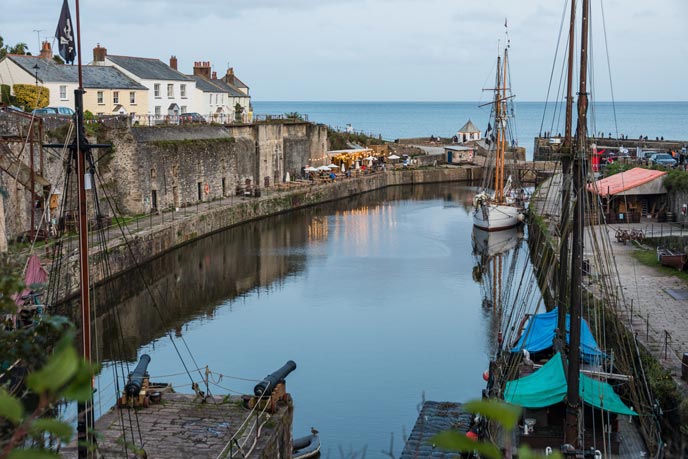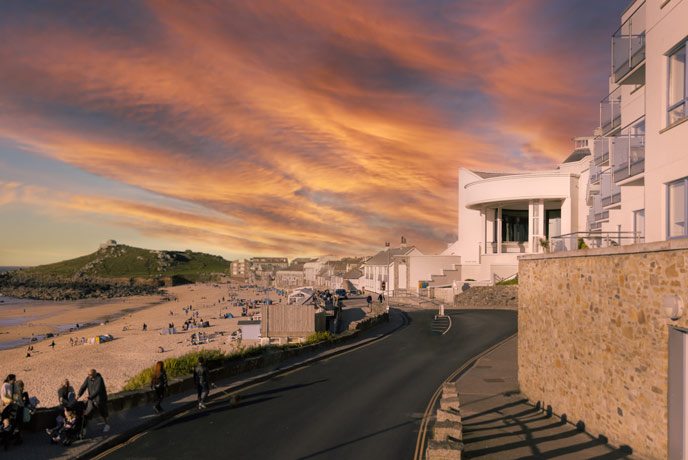For hundreds of years the historic manor houses of Cornwall and the great families that lived in them were at the very heart of Cornish society. They were seats of great political and industrial power. The wealthiest folks of the region created comfortable homes for themselves in every corner of this wild peninsula and generations of those families filled those houses with treasures and surrounded themselves with beautiful gardens and parkland.
In the past these places were the domain of a lucky few but today their doors have been flung open for us to step through time and explore. Like marvellous museums, the great houses of Cornwall are filled with a treasure-trove of paintings, antiques, and furniture, the possessions and memories of those that once lived there; and they give us a precious and exciting glimpse into the past.
Ready to step back in time? Here are some utterly enchanting historic houses in Cornwall to kick off your explorations…
Cotehele, Saltash

Now in the care of the National Trust, this stunning Tudor manor house stands on high ground above the Tamar River. It is considered one of the finest houses in Cornwall for the amazing preservation of its buildings and its ornate gardens and orchards. It’s a true time capsule of Cornish history.
Hidden within a maze of quiet lanes, it can feel as if you stumble on Cotehele by chance. The house takes its name from Hilaria de Cotehele who married William Edgcumbe in 1353, though during her time Cotehele was a much smaller, more modest home. Much of what we see today was built by Sir Richard Edgcumbe, knighted by King Henry VII on the battlefield at Bosworth, and his son Piers in the mid 15th and early 16th centuries.
Highlights include the breath-taking Great Hall c1520 with its high beamed ceiling, which today is filled with a collection of armour and weapons, ancient clocks and tapestries, and King Charles’ bedroom, where the monarch is said to have slept during the Civil War.
Cotehele really does live up to the old cliché of ‘stepping back in time’ and once you have enjoyed all it has to offer, if you fancy going even further back into the past you are just a short hop from Bodmin Moor and the prehistoric wonders of the Hurlers and the Cheesewring!
Lanhydrock, Bodmin
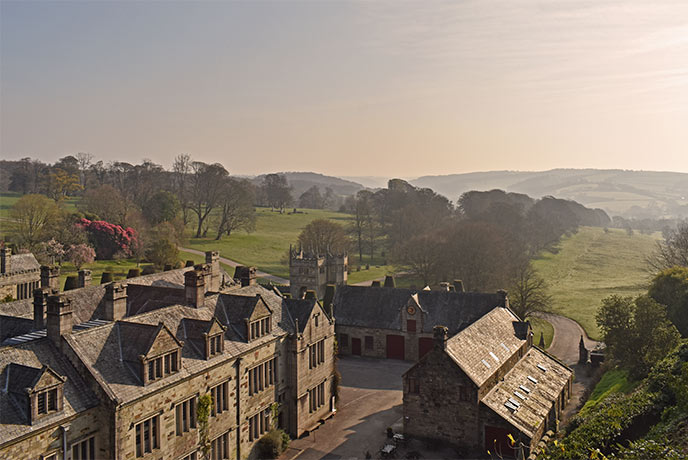
The extensive estate surrounding this house covers some 890 acres and contains miles and miles of picturesque woodland walks, and at its heart stands the elegant Lanhydrock House. The walls of this house are filled with fascinating and moving stories relating to the Agar-Robartes family who lived here for about 300 years.
Lanhydrock was first constructed in the 1620s though much of what you see today was rebuilt in the Victorian era. The family’s wealth, like so many in Cornwall, came from tin, but as dealers rather than miners, and Richard Robartes was described as “the richest money-lender in Cornwall” in 1613. The family were staunch supporters of the Royalist cause during the Civil War and a garrison of troops was once based at the house.
Perhaps the greatest event in Lanhydrock’s history however was the devastating fire that nearly destroyed the house in 1881. Only the north wing and the entrance porch survived and fortunately the 17th century long gallery with its magnificent plaster ceiling was saved from the flames. At 29 metres in length, the gallery is a breath-taking work of art; and combined with the rest of the house, crammed full of the family’s belongings and captivating objects gathered from across the globe, there is much to inspire and spark your imagination.
For those who want to see more of the surrounding countryside, one of the best ways to arrive at Lanhydrock is by train. Bodmin Station is roughly a 1.5 mile walk away from the house through the wilds of the estate, and the main line also links with the wonderful Bodmin and Wenford Steam Railway, which runs 13-mile journeys through the stunning local scenery.
Antony House, Torpoint

Antony House and its estate lies hidden in the quiet countryside of the isolated Rame Peninsula, hemmed in on two sides by the waters of the Lynher River and the great river Tamar.
The Carew family, one of the great ancient dynasties of Cornwall, came to Antony in the 15th century, although the house we see today was built in 1721. Close to the Tamar and surrounded by 250 acres of sprawling parkland, the house is one of the finest Queen Anne style buildings in the country. Its walls are hung with numerous portraits of the family and the rooms are filled with 18th century furniture and textiles.
As grand as the house is, it’s often the gardens that surround the house that truly enchant visitors. The beautiful sculptures, manicured trees and intricate topiary hedges create a delightful and intriguing space that has even inspired director and visual icon, Tim Burton.
In 2008, around 400 cast and crew from London and America flocked to Antony House to film Walt Disney’s remake of Alice in Wonderland. The beautiful house and its atmospheric grounds were transformed into the perfect fantasy location for Burton’s colourful film starring Johnny Depp, Helena Bonham Carter, and Anne Hathaway.
From Antony you can continue your adventure in this beautiful part of Cornwall with a visit to the tiny 14th century chapel on Rame Head, or drop in to the twin smuggling villages of Kingsand and Cawsand for some mouth-watering fish and chips.
Trewithen House, Truro

Another Cornish house that is famed for its gardens but often overlooked is Trewithen near Truro. It too has featured on film as a location for two Rosamunde Pilcher movies set in Cornwall and the house itself, which has passed down through ten generations of the same family, is an incredible time capsule.
Trewithen has recently undergone a period of restoration to properly preserve its incredible interior, while the house has hardly changed in about 300 years. The rooms here are intimate, boast architectural features unlike anything else in Cornwall, and are filled with the everyday miscellanea of so many fascinating lives. It really is like stepping into a bygone era.
Trewithen in Cornish means ‘house of the trees’ and it certainly lives up to this name as the present owner alone has planted some 30,000 trees! Over the centuries the family has stocked their stunning landscaped gardens and woodlands with species of trees and shrubs from across the globe, brought back to Cornwall by the famous ‘Plant Hunters’. But another furrier species is making a comeback here too...
In 2012, the family took delivery of two female red squirrels, one of the country’s most endangered species, and King Charles, who as Prince of Wales was President of the Red Squirrel Survival Trust, released a male into the enclosure soon after to create a breeding population in Cornwall. The offspring produced by the red squirrels at Trewithen have then been released in other areas of the country where there are already red squirrels in the wild. Trewithen House is only open for small guided tours in the summer, as it remains a family home to this day, while the café, gardens and walking routes are open year round.
Trerice, Newquay
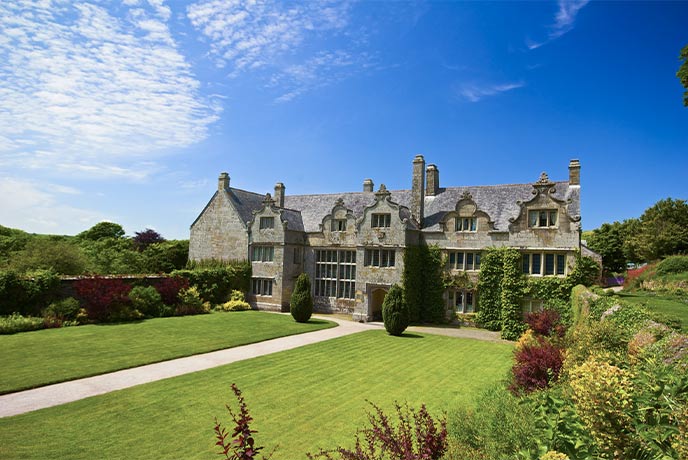
This Elizabethan manor house tucked away in the countryside not far from Newquay was home to the Arundell family for a whopping 500 years. With unusual Dutch style gables and laid out in the shape of the letter E as homage to his queen, John Arundell V’s home was at the time a magnificent country residence for a prosperous and well connected gent.
The Great Hall at Trerice, built around 1572, has a wonderful plaster-work ceiling and some fascinating pieces of Civil War armour. The large, striking window is a key feature of the hall and is made up of 576 pieces of 16th- to 19th-century glass - can you spot the historic graffiti that has been scratched onto some of the tiles of glass?
Throughout Trerice you will discover treasures from the history of the house and Cornwall at every turn. There are 300 year old clocks, delicately embroidered panels from the 16th and 17th century, and hanging in the Long Gallery the amazing Arundell Charter. This document was written by King Charles II when he returned to the throne and made Richard Arundell a Baron in recognition of his bravery fighting for the Royalist cause during the Civil War.
Pentillie, St Mellion
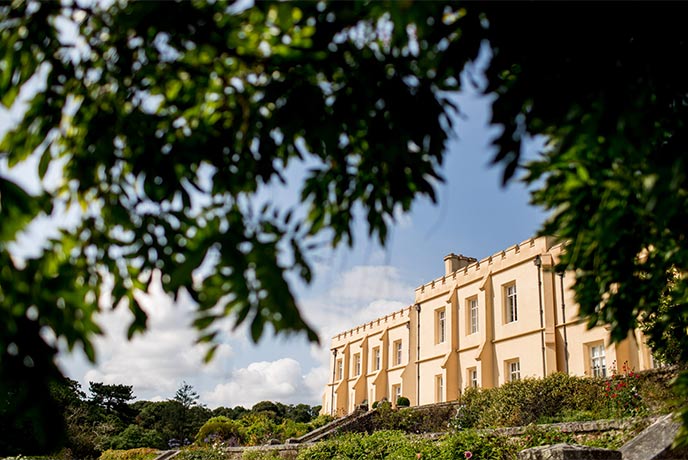
Although Pentillie is traditionally known as a ‘castle’ to look at, it really is more of a large country house with castellated walls. Originally built by Sir James Tillie in 1698, it was surrounded by a vast estate of some 20,000 acres of land. Since that time there has been extensive remodelling and enlarging of the house giving us the grand building that we see today.
Sir James Tillie was actually from a humble background but found his way to wealth through hard work and a fortunate marriage. He is also responsible for one of the most fascinating legends told about Pentillie.
It is said that before Sir James Tillie mysteriously passed away aged just 42, he asked to have his body interred in a purpose-built mausoleum on the estate, so he would be “ready for his resurrection”. His will instructed that he was to be dressed in his finest clothes and bound to a stout chair with his books placed around him, a bottle of wine and his pipe. Tillie’s imposing memorial still stands on a wooded hill above the house and a rather spooky life size statue of the man seated on a chair can be seen inside. The strange story was long thought to be mere myth until in 2013 when archaeologists actually uncovered human remains beneath the mausoleum, leading some to believe that there might be some truth to the legend.
In recent years, Pentillie Castle enjoyed new fame when it was featured in the Channel 4 programme Country House Rescue, leading to it being used as a set for various film and television projects. Pentillie has now become an exclusive venue for weddings and business retreats, but the grounds are open to visitors for garden visits and you can also treat yourself to a mouth-watering afternoon tea inside the castle (must be booked in advance).
Godolphin House, Helston
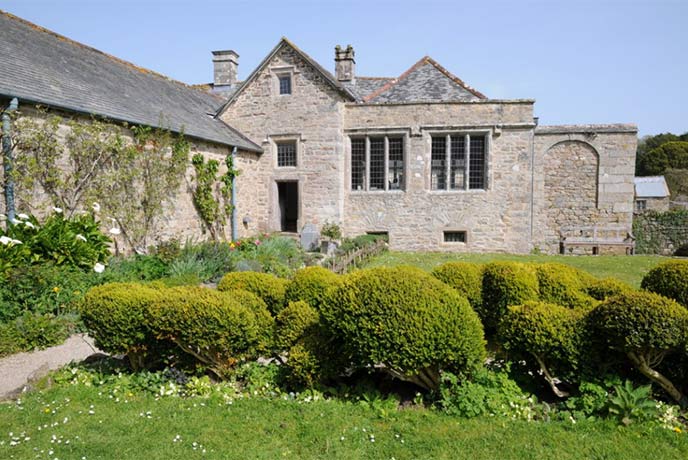
Another Cornish property cared for by the National Trust, the enchanting Godolphin House is one of the oldest and most impressive in Cornwall. Its long grey walls end in a colonnade of giant granite pillars supporting the overhanging rooms, some of which date back to the 1470s. The house was added to at various times over the centuries as the owners’ fortunes rose and fell, so there are parts that date from the Tudor, Elizabethan, Stuart and Gothic periods.
The Godolphins after whom the house is named were one of the great landowning families in the region, making their money from tin and smarts – there was a Cornish proverb that “A Godolphin never wanted for wit”. They were charismatic men who served, fought, and died for various monarchs of England, two of which are said to have stayed at the house.
One of the greatest attractions of Godolphin, however, is that it still feels like a home; one where time has stopped. It may be the presence of the resident ghost, but you can almost imagine that you hear the swish of silken gowns sweeping across the floorboards from room to room, or the clatter of horse’s hooves on the cobbled courtyard outside.
The estate is open all year round and famed for its bluebell displays in spring, while the house itself is open to the public one weekend a month and is wonderfully positioned within easy reach of both the Lizard and West Cornwall so the opportunities for adventures are endless!
Ready to explore Cornwall’s unique history? Discover our collection of welcoming holiday cottages.




